Bibliometric Network Analysis of Trends in Cyclone Separator Research: Research Gaps and Future Direction
Abstract
1. Introduction
1.1. Research Objectives
1.2. Research Organization
2. Data and Methods
2.1. Database Creation
2.2. Visualization and Analysis of Data
3. Results
3.1. Publication Trends
3.2. Contributing Countries
3.3. Research Collaboration and Institutions
3.4. Keywords Analysis
3.5. Contribution of Journals
3.6. Most Influential Authors
3.7. Most Cited Documents
4. Discussion
4.1. Summary of the Findings
4.2. Limitations
4.3. Suggestions for Future Research
4.3.1. Evaluation of the Performance of the Cyclone Separator Using Road Dust Samples
4.3.2. The Performance of Cyclone Separators under Varying Particle Properties
5. Conclusions
Supplementary Materials
Author Contributions
Funding
Institutional Review Board Statement
Informed Consent Statement
Data Availability Statement
Acknowledgments
Conflicts of Interest
References
- Kanojiya, M.T.; Mandavgade, N.; Kalbande, V.; Padole, C. Design and fabrication of cyclone dust collector for industrial Application. Mater. Today Proc. 2022, 49, 378–382. [Google Scholar] [CrossRef]
- Sonawane, C.R.; Dhanorkar, M.; Mishra, I.; Kirdat, A.; Bhatwadekar, S.; Sawant, R.; Pandey, A. Numerical simulation of hydro-cyclone separator used for separation of highly dense suspended particulate matter. Mater. Today Proc. 2022, 59, 85–92. [Google Scholar] [CrossRef]
- Bächler, P.; Szabadi, J.; Meyer, J.; Dittler, A. Simultaneous measurement of spatially resolved particle emissions in a pilot plant scale baghouse filter applying distributed low-cost particulate matter sensors. J. Aerosol Sci. 2020, 150, 105644. [Google Scholar] [CrossRef]
- Yang, J.; Tang, T.; Jiang, Y.; Karavalakis, G.; Durbin, T.D.; Wayne Miller, J.; Cocker, D.R.; Johnson, K.C. Controlling emissions from an ocean-going container vessel with a wet scrubber system. Fuel 2021, 304, 121323. [Google Scholar] [CrossRef]
- Erman Caliskan, M.; Karagoz, I.; Avci, A.; Surmen, A. An experimental investigation into the particle classification capability of a novel cyclone separator. Sep. Purif. Technol. 2019, 209, 908–913. [Google Scholar] [CrossRef]
- Singh, A.; Rana, V. Exploration of modified cyclone separator for the enhanced recovery of inhalable spray dried cubosomal powder intended to be used for lung delivery. J. Drug Deliv. Sci. Technol. 2021, 66, 102848. [Google Scholar] [CrossRef]
- Lim, J.-H.; Yook, S.-J. Development of a high-volume ambient aerosol sampling inlet with an adjustable cutoff size and its performance evaluation using road dust. Environ. Res. 2022, 204, 112302. [Google Scholar] [CrossRef]
- Borhani Jebeli, M.; Moridi, P.; Beheshti, M.H.; Yarahmadi, R. A new cyclone design with adjustable inlet angle and external geometry for optimal PM10 removal. Int. J. Environ. Sci. Technol. 2020, 17, 1075–1086. [Google Scholar] [CrossRef]
- Yohana, E.; Tauviqirrahman, M.; Yusuf, B.; Choi, K.-H.; Paramita, V. Effect of vortex limiter position and metal rod insertion on the flow field, heat rate, and performance of cyclone separator. Powder Technol. 2021, 377, 464–475. [Google Scholar] [CrossRef]
- Haake, J.; Oggian, T.; Utzig, J.; Rosa, L.M.; Meier, H.F. Investigation of the pressure drop increase in a square free-vortex cyclonic separator operating at low particle concentration. Powder Technol. 2020, 374, 95–105. [Google Scholar] [CrossRef]
- Wójtowicz, R.W.P.W.-W.A. Numerical and Experimental Analysis of Flow Pattern, Pressure Drop Collection Efficiency in a Cyclone with a Square, Inlet Different Dimensions of a Vortex, Finder. Energies 2021, 14, 111. [Google Scholar] [CrossRef]
- Karagoz, I.; Avci, A.; Surmen, A.; Sendogan, O. Design and performance evaluation of a new cyclone separator. J. Aerosol Sci. 2013, 59, 57–64. [Google Scholar] [CrossRef]
- Jafarnezhad, A.; Salarian, H.; Kheradmand, S.; Khaleghinia, J. Performance improvement of a cyclone separator using different shapes of vortex finder under high-temperature operating condition. J. Braz. Soc. Mech. Sci. Eng. 2021, 43, 81. [Google Scholar] [CrossRef]
- Venkatesh, S.; Sakthivel, M.; Saranav, H.; Saravanan, N.; Rathnakumar, M.; Santhosh, K.K. Performance investigation of the combined series and parallel arrangement cyclone separator using experimental and CFD approach. Powder Technol. 2020, 361, 1070–1080. [Google Scholar] [CrossRef]
- Yamasaki, H.; Kizilkan, Ö.; Yamaguchi, H.; Kamimura, T.; Hattori, K.; Nekså, P. Experimental investigation of dry ice cyclone separator for ultra-low temperature energy storage using carbon dioxide. Energy Storage 2020, 2, e149. [Google Scholar] [CrossRef]
- Modabberifar, M.; Nazaripoor, H.; Safikhani, H. Modeling and numerical simulation of flow field in three types of standard new design cyclone separators. Adv. Powder Technol. 2021, 32, 4295–4302. [Google Scholar] [CrossRef]
- Behrang, M.; Shirvani, M.; Hashemabadi, S.H. Multi-Helical-Channel dust separator: CFD simulation and experiment. Chem. Eng. Res. Des. 2019, 146, 1–10. [Google Scholar] [CrossRef]
- Chen, L.; Ma, H.; Sun, Z.; Ma, G.; Li, P.; Li, C.; Cong, X. Effect of inlet periodic velocity on the performance of standard cyclone separators. Powder Technol. 2022, 402, 117347. [Google Scholar] [CrossRef]
- Kozołub, P.; Klimanek, A.; Białecki, R.A.; Adamczyk, W.P. Numerical simulation of a dense solid particle flow inside a cyclone separator using the hybrid Euler–Lagrange approach. Particuology 2017, 31, 170–180. [Google Scholar] [CrossRef]
- Gao, Z.-W.; Liu, Z.-X.; Wei, Y.-D.; Li, C.-X.; Wang, S.-H.; Qi, X.-Y.; Huang, W. Numerical analysis on the influence of vortex motion in a reverse Stairmand cyclone separator by using LES model. Pet. Sci. 2022, 19, 848–860. [Google Scholar] [CrossRef]
- El-Emam, M.A.; Zhou, L.; Shi, W.; Han, C. Performance evaluation of standard cyclone separators by using CFD–DEM simulation with realistic bio-particulate matter. Powder Technol. 2021, 385, 357–374. [Google Scholar] [CrossRef]
- Park, D.; Go, J.S. Design of Cyclone Separator Critical Diameter Model Based on Machine Learning and CFD. Processes 2020, 8, 1521. [Google Scholar] [CrossRef]
- Izadi, A.; Kashani, E.; Mohebbi, A. Combining 10 meta-heuristic algorithms, CFD, DOE, MGGP and PROMETHEE II for optimizing Stairmand cyclone separator. Powder Technol. 2021, 382, 70–84. [Google Scholar] [CrossRef]
- Donthu, N.; Kumar, S.; Mukherjee, D.; Pandey, N.; Lim, W.M. How to conduct a bibliometric analysis: An overview and guidelines. J. Bus. Res. 2021, 133, 285–296. [Google Scholar] [CrossRef]
- Aria, M.; Cuccurullo, C. bibliometrix: An R-tool for comprehensive science mapping analysis. J. Informetr. 2017, 11, 959–975. [Google Scholar] [CrossRef]
- Semerjian, L.; Okaiyeto, K.; Ojemaye, M.O.; Ekundayo, T.C.; Igwaran, A.; Okoh, A.I. Global Systematic Mapping of Road Dust Research from to Research Gaps Future, Direction. Sustainability 2021, 13, 11516. [Google Scholar] [CrossRef]
- Youngblood, M.; Lahti, D. A bibliometric analysis of the interdisciplinary field of cultural evolution. Palgrave Commun. 2018, 4, 120. [Google Scholar] [CrossRef]
- Zhang, Y.; Zhang, T.; Liu, X.; Zhang, L.; Hong, F.; Lu, M. Research trends of pregnancy with scarred uterus after cesarean: A bibliometric analysis from 1999 to 2018. J. Matern. -Fetal Neonatal Med. 2022, 35, 3555–3564. [Google Scholar] [CrossRef]
- Du, Y.-Q.; Zhu, G.-D.; Cao, J.; Huang, J.-Y. Research supporting malaria control and elimination in China over four decades: A bibliometric analysis of academic articles published in Chinese from 1980 to 2019. Malar. J. 2021, 20, 158. [Google Scholar] [CrossRef]
- Sun, J.; Zhou, Z.; Huang, J.; Li, G. A Bibliometric Analysis of the Impacts of Air Pollution on Children. Int. J. Environ. Res. Public Health 2020, 17, 1277. [Google Scholar] [CrossRef]
- Sarkodie, S.A.; Owusu, P.A. Bibliometric analysis of water–energy–food nexus: Sustainability assessment of renewable energy. Curr. Opin. Environ. Sci. Health 2020, 13, 29–34. [Google Scholar] [CrossRef]
- Sharifi, A. Urban sustainability assessment: An overview and bibliometric analysis. Ecol. Indic. 2021, 121, 107102. [Google Scholar] [CrossRef]
- Can-Güven, E. Microplastics as emerging atmospheric pollutants: A review and bibliometric analysis. Air Qual. Atmos. Health 2021, 14, 203–215. [Google Scholar] [CrossRef]
- Su, Y.; Yu, Y.; Zhang, N. Carbon emissions and environmental management based on Big Data and Streaming Data: A bibliometric analysis. Sci. Total Environ. 2020, 733, 138984. [Google Scholar] [CrossRef]
- Miao, Y.; Zhang, Y.; Yin, L. Trends in hepatocellular carcinoma research from 2008 to 2017: A bibliometric analysis. PeerJ 2018, 6, e5477. [Google Scholar] [CrossRef]
- Mahi, M.; Mobin, M.A.; Habib, M.; Akter, S. A bibliometric analysis of pandemic and epidemic studies in economics: Future agenda for COVID-19 research. Soc. Sci. Humanit. Open 2021, 4, 100165. [Google Scholar] [CrossRef]
- Gan, L.; Jiang, P.; Lev, B.; Zhou, X. Balancing of supply and demand of renewable energy power system: A review and bibliometric analysis. Sustain. Futures 2020, 2, 100013. [Google Scholar] [CrossRef]
- Liu, Z.; Yang, J.; Zhang, J.; Xiang, H.; Wei, H. A Bibliometric Analysis of Research on Acid Rain. Sustainability 2019, 11, 3077. [Google Scholar] [CrossRef]
- Jia, Y.; Chen, Y.; Yan, P.; Huang, Q. Bibliometric Analysis on Global Research Trends of Airborne Microorganisms in Recent Ten Years (2011–2020). Aerosol Air Qual. Res. 2021, 21, 200497. [Google Scholar] [CrossRef]
- Yang, Y.; Chen, G.; Reniers, G.; Goerlandt, F. A bibliometric analysis of process safety research in China: Understanding safety research progress as a basis for making China’s chemical industry more sustainable. J. Clean. Prod. 2020, 263, 121433. [Google Scholar] [CrossRef]
- Liu, W. Caveats for the use of Web of Science Core Collection in old literature retrieval and historical bibliometric analysis. Technol. Forecast. Soc. Chang. 2021, 172, 121023. [Google Scholar] [CrossRef]
- Mascarenhas, C.; Ferreira, J.J.; Marques, C. University–industry cooperation: A systematic literature review and research agenda. Sci. Public Policy 2018, 45, 708–718. [Google Scholar] [CrossRef]
- Dhital, S.; Rupakheti, D. Bibliometric analysis of global research on air pollution and human health: 1998–2017. Environ. Sci. Pollut. Res. 2019, 26, 13103–13114. [Google Scholar] [CrossRef] [PubMed]
- Agbo, F.J.; Sanusi, I.T.; Oyelere, S.S.; Suhonen, J. Application of Virtual Reality in Computer Science Education: A Systemic Review Based on Bibliometric and Content Analysis Methods. Educ. Sci. 2021, 11, 142. [Google Scholar] [CrossRef]
- Fardi, A.; Kodonas, K.; Gogos, C.; Economides, N. Top-cited Articles in Endodontic Journals. J. Endod. 2011, 37, 1183–1190. [Google Scholar] [CrossRef]
- Jancsek-Turóczi, B.; Hoffer, A.; Nyírő-Kósa, I.; Gelencsér, A. Sampling and characterization of resuspended and respirable road dust. J. Aerosol Sci. 2013, 65, 69–76. [Google Scholar] [CrossRef][Green Version]
- Aslam, J.; Khan, S.A.; Khan, S.H. Heavy metals contamination in roadside soil near different traffic signals in Dubai, United Arab Emirates. J. Saudi Chem. Soc. 2013, 17, 315–319. [Google Scholar] [CrossRef]
- Altuwayjiri, A.; Pirhadi, M.; Kalafy, M.; Alharbi, B.; Sioutas, C. Impact of different sources on the oxidative potential of ambient particulate matter PM10 in Riyadh, Saudi Arabia: A focus on dust emissions. Sci. Total Environ. 2022, 806, 150590. [Google Scholar] [CrossRef]
- Lv, T.; Wang, L.; Xie, H.; Zhang, X.; Zhang, Y. Evolutionary overview of water resource management (1990–2019) based on a bibliometric analysis in Web of Science. Ecol. Inform. 2021, 61, 101218. [Google Scholar] [CrossRef]
- Ojemaye, M.O.; Okoh, A.I. Global research direction on Pt and Pt based electro-catalysts for fuel cells application between 1990 and 2019: A bibliometric analysis. Int. J. Energy Res. 2021, 45, 15783–15796. [Google Scholar] [CrossRef]
- Zhou, P.; Tijssen, R.; Leydesdorff, L. University-Industry Collaboration in China and the USA: A Bibliometric Comparison. PLoS ONE 2016, 11, e0165277. [Google Scholar] [CrossRef] [PubMed]
- Loving, V.A. Collaborative interdepartmental teams: Benefits, challenges, alternatives, and the ingredients for team success. Clin. Imaging 2021, 69, 301–304. [Google Scholar] [CrossRef] [PubMed]
- Puljak, L.; Vari, S.G. Significance of research networking for enhancing collaboration and research productivity. Croat. Med. J. 2014, 55, 181–183. [Google Scholar] [CrossRef] [PubMed]
- Cheng, Q.; Wang, J.; Lu, W.; Huang, Y.; Bu, Y. Keyword-citation-keyword network: A new perspective of discipline knowledge structure analysis. Scientometrics 2020, 124, 1923–1943. [Google Scholar] [CrossRef]
- Polat, Z.A.; Alkan, M.; Paulsson, J.; Paasch, J.M.; Kalogianni, E. Global scientific production on LADM-based research: A bibliometric analysis from 2012 to 2020. Land Use Policy 2022, 112, 105847. [Google Scholar] [CrossRef]
- Karagoz, I.; Kaya, F. CFD investigation of the flow and heat transfer characteristics in a tangential inlet cyclone. Int. Commun. Heat Mass Transf. 2007, 34, 1119–1126. [Google Scholar] [CrossRef]
- Wang, L.; Chen, E.; Ma, L.; Yang, Z.; Li, Z.; Yang, W.; Wang, H.; Chang, Y. Numerical simulation and experimental study of gas cyclone–liquid jet separator for fine particle separation. Chin. J. Chem. Eng. 2021, 51, 43–52. [Google Scholar] [CrossRef]
- Aksnes, D.W.; Langfeldt, L.; Wouters, P. Citations, Citation Indicators, and Research Quality: An Overview of Basic Concepts and Theories. SAGE Open 2019, 9, 2158244019829575. [Google Scholar] [CrossRef]
- Van Noorden, R.; Maher, B.; Nuzzo, R. The top 100 papers. Nat. News 2014, 514, 550. [Google Scholar] [CrossRef]
- Cooper, I.D. Bibliometrics basics. J. Med. Libr. Assoc. 2015, 103, 217–218. [Google Scholar] [CrossRef]
- Misiulia, D.; Andersson, A.G.; Lundström, T.S. Large Eddy Simulation Investigation of an Industrial Cyclone Separator Fitted with a Pressure Recovery Deswirler. Chem. Eng. Technol. 2017, 40, 709–718. [Google Scholar] [CrossRef]
- Hamdy, O.; Bassily, M.A.; El-Batsh, H.M.; Mekhail, T.A. Numerical study of the effect of changing the cyclone cone length on the gas flow field. Appl. Math. Model. 2017, 46, 81–97. [Google Scholar] [CrossRef]
- Du, P.; Liu, J.; Gui, H.; Zhang, J.; Yu, T.; Wang, J.; Cheng, Y.; Lu, Y.; Yao, Y.; Fu, Q.; et al. Development of a static test apparatus for evaluating the performance of three PM2.5 separators commonly used in China. J. Environ. Sci. 2020, 87, 238–249. [Google Scholar] [CrossRef]
- Fu, S.; Zhou, F.; Sun, G.; Yuan, H.; Zhu, J. Performance evaluation of industrial large-scale cyclone separator with novel vortex finder. Adv. Powder Technol. 2021, 32, 931–939. [Google Scholar] [CrossRef]
- Casotti Rienda, I.; Alves, C.A. Road dust resuspension: A review. Atmos. Res. 2021, 261, 105740. [Google Scholar] [CrossRef]
- Health Effects Institute. State of Global Air 2020. Data source: Global Burden of Disease Study 2019. IHME. 2020. Available online: https://www.stateofglobalair.org/sites/default/files/documents/2020-10/soga-2020-report-10-26_0.pdf (accessed on 16 June 2022).
- Yilbas, B.S.; Hassan, G.; Yilbas, A.E.; Abubakar, A.A.; Al-Qahtani, H. On the Mechanism of Human Saliva Interaction with Environmental Dust in Relation to Spreading of Viruses. Langmuir 2021, 37, 4714–4726. [Google Scholar] [CrossRef]
- Magnano, G.C.; Marussi, G.; Pavoni, E.; Adami, G.; Larese Filon, F.; Crosera, M. Percutaneous metals absorption following exposure to road dust powder. Environ. Pollut. 2022, 292, 118353. [Google Scholar] [CrossRef]
- Shrimpton, J.S.; Crane, R.I. Small Electrocyclone Performance. Chem. Eng. Technol. 2001, 24, 951–955. [Google Scholar] [CrossRef]
- Carotenuto, C.; Di Natale, F.; Lancia, A. Wet electrostatic scrubbers for the abatement of submicronic particulate. Chem. Eng. J. 2010, 165, 35–45. [Google Scholar] [CrossRef]
- Brouwers, J.J.H. Particle collection efficiency of the rotational particle separator. Powder Technol. 1997, 92, 89–99. [Google Scholar] [CrossRef]
- Paiva, J.; Salcedo, R.; Araujo, P. Impact of particle agglomeration in cyclones. Chem. Eng. J. 2010, 162, 861–876. [Google Scholar] [CrossRef]
- Haig, C.W.; Hursthouse, A.; McIlwain, S.; Sykes, D. The effect of particle agglomeration and attrition on the separation efficiency of a Stairmand cyclone. Powder Technol. 2014, 258, 110–124. [Google Scholar] [CrossRef]
- Ahuja, S.M. Wetted wall cyclone—A novel concept. Powder Technol. 2010, 204, 48–53. [Google Scholar] [CrossRef]
- Kim, G.-N.; Choi, W.-K.; Jung, C.-H. The development and performance evaluation of a cyclone train for the removal of contaminated hot particulate in a hot cell. Sep. Purif. Technol. 2007, 55, 313–320. [Google Scholar] [CrossRef]
- Matthaios, V.N.; Lawrence, J.; Martins, M.A.G.; Ferguson, S.T.; Wolfson, J.M.; Harrison, R.M.; Koutrakis, P. Quantifying factors affecting contributions of roadway exhaust and non-exhaust emissions to ambient PM10–2.5 and PM2.5–0.2 particles. Sci. Total Environ. 2022, 835, 155368. [Google Scholar] [CrossRef]
- Alshetty, D.; Nagendra, S.M.S. Impact of vehicular movement on road dust resuspension and spatiotemporal distribution of particulate matter during construction activities. Atmos. Pollut. Res. 2022, 13, 101256. [Google Scholar] [CrossRef]
- Kumar, V.; Jha, K. Effects of Mass-Loading on Performance of the Cyclone Separators. In Applications of Computational Fluid Dynamics Simulation and Modeling; IntechOpen: London, UK, 2022. [Google Scholar] [CrossRef]
- Li, Y.; Qin, G.; Xiong, Z.; Ji, Y.; Fan, L. The effect of particle humidity on separation efficiency for an axial cyclone separator. Adv. Powder Technol. 2019, 30, 724–731. [Google Scholar] [CrossRef]
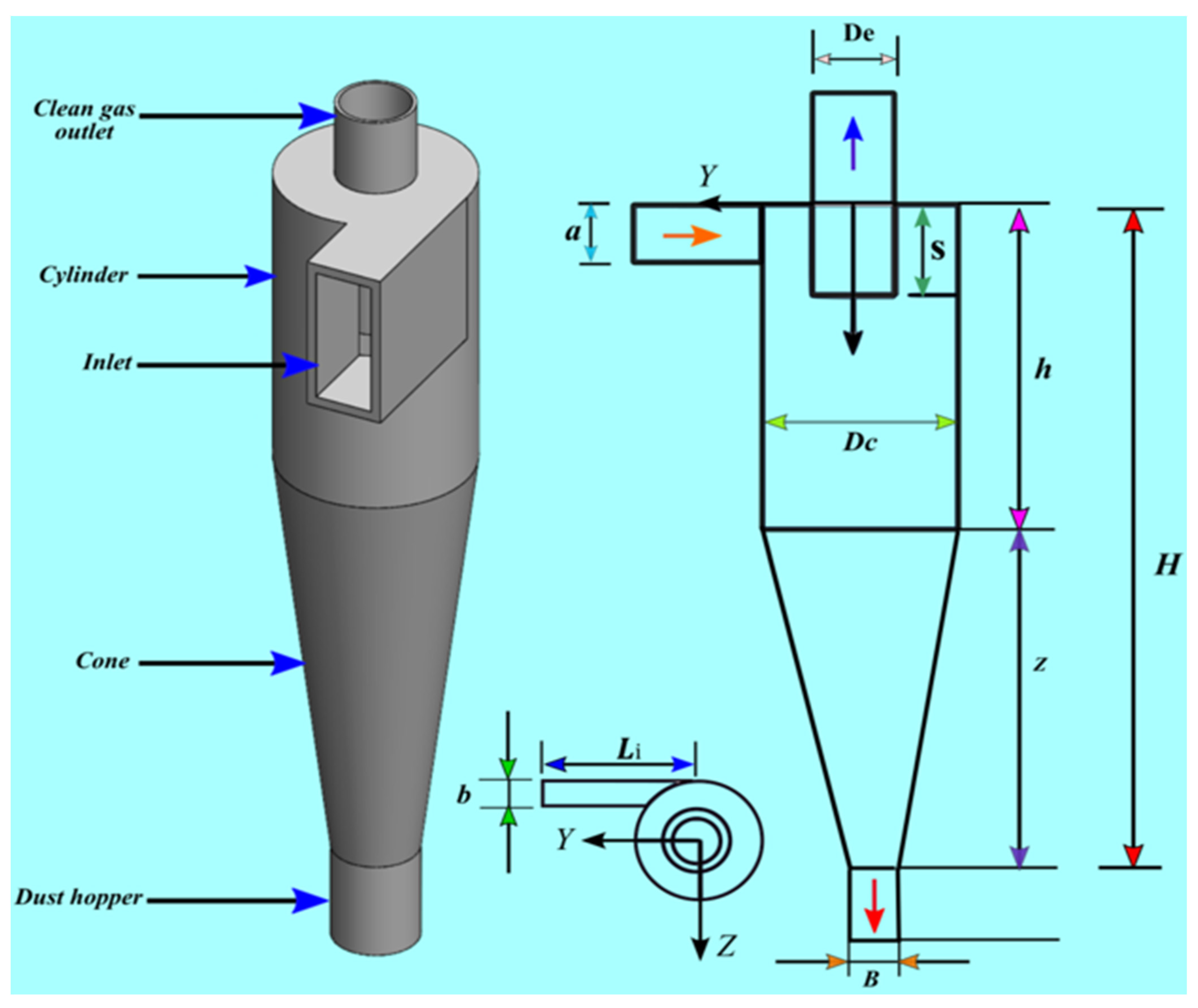
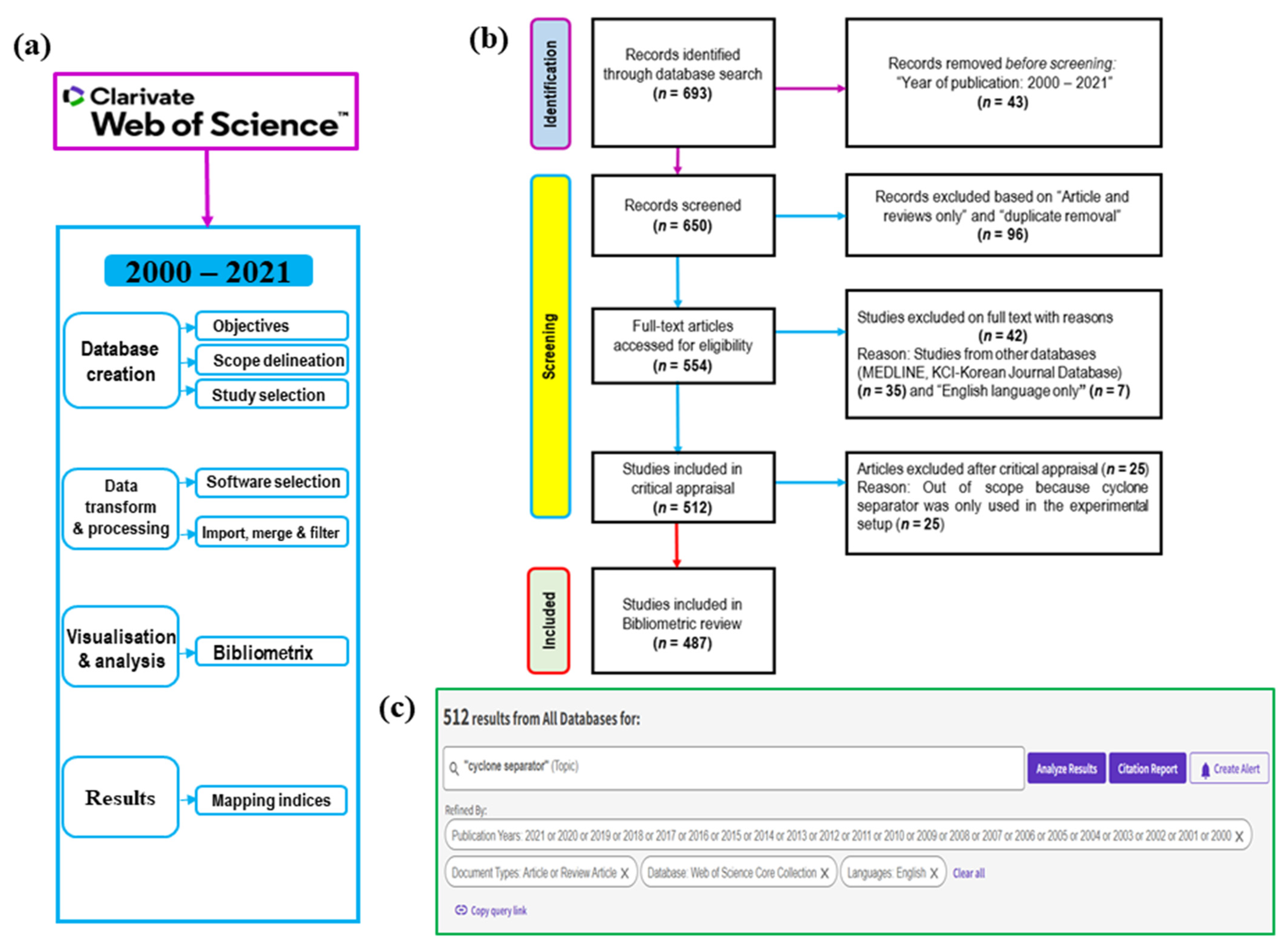
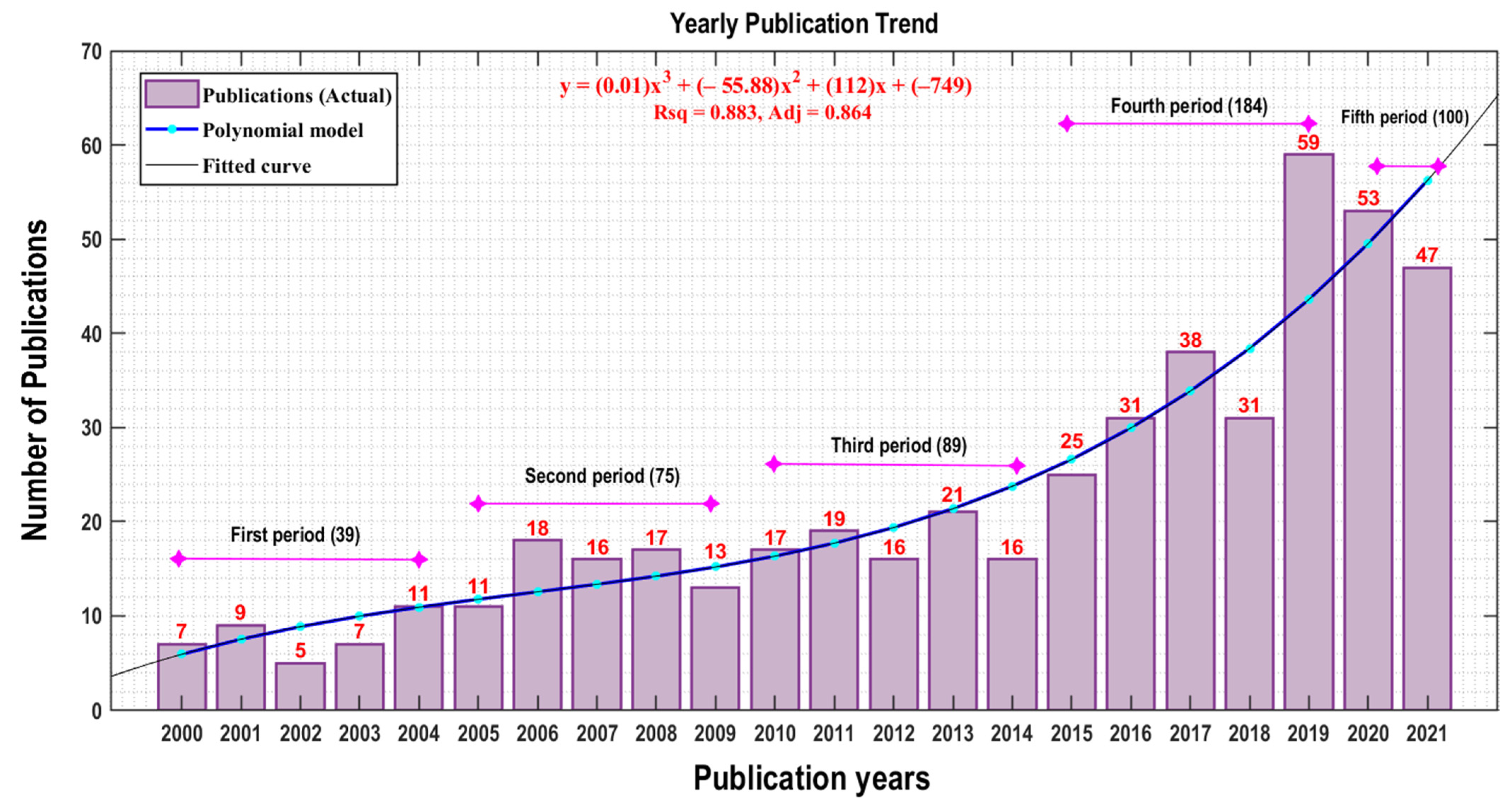
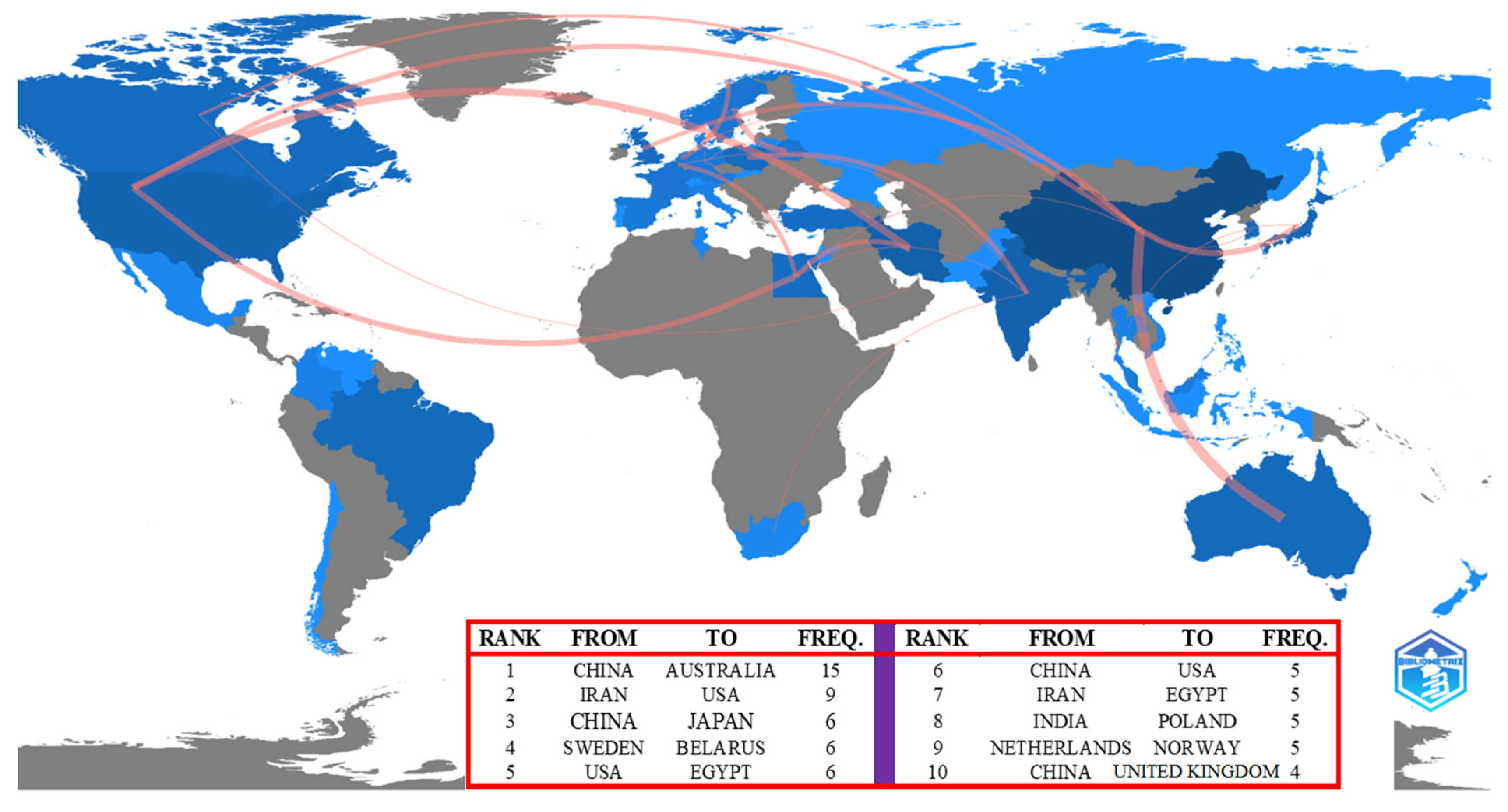
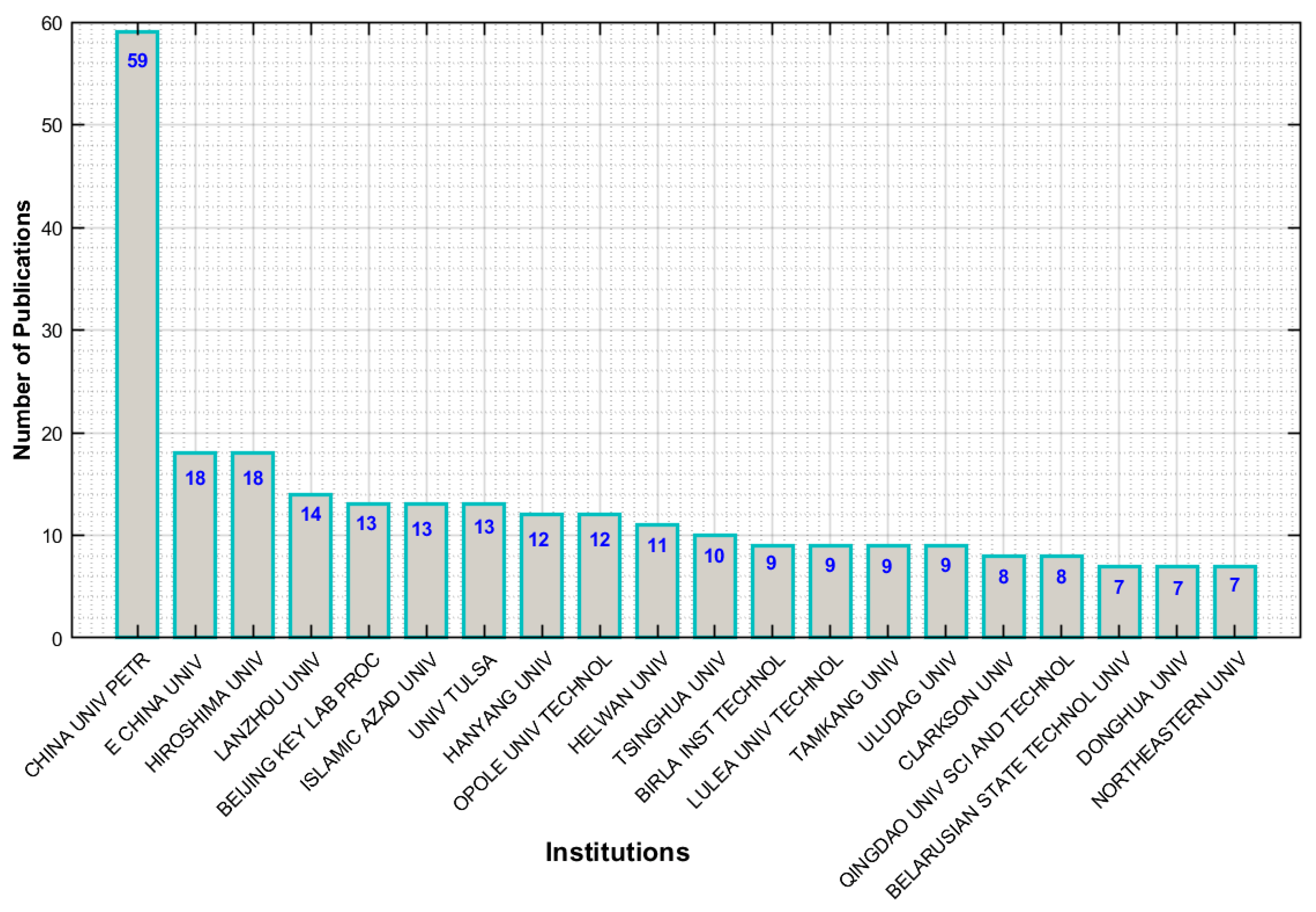
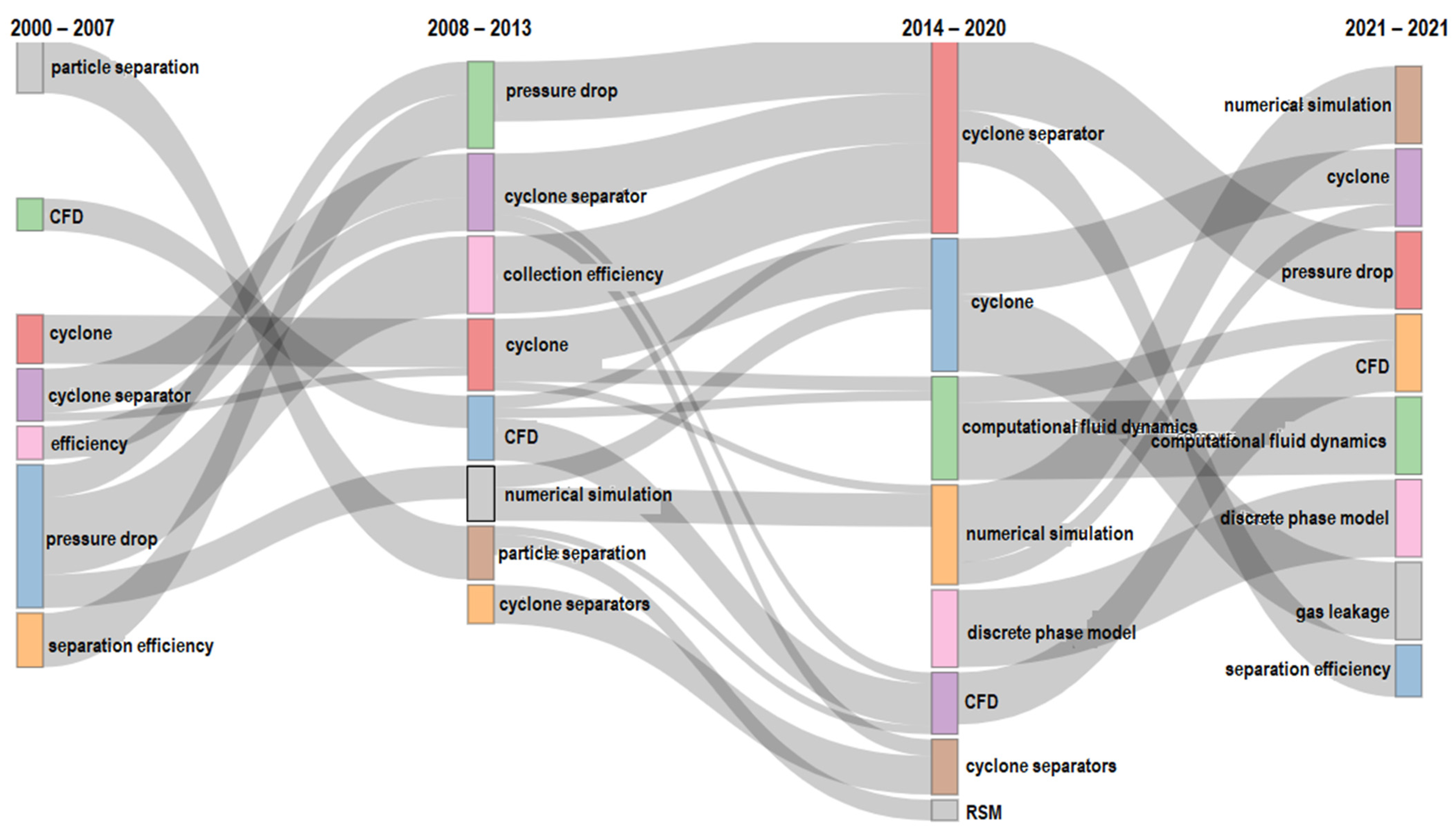
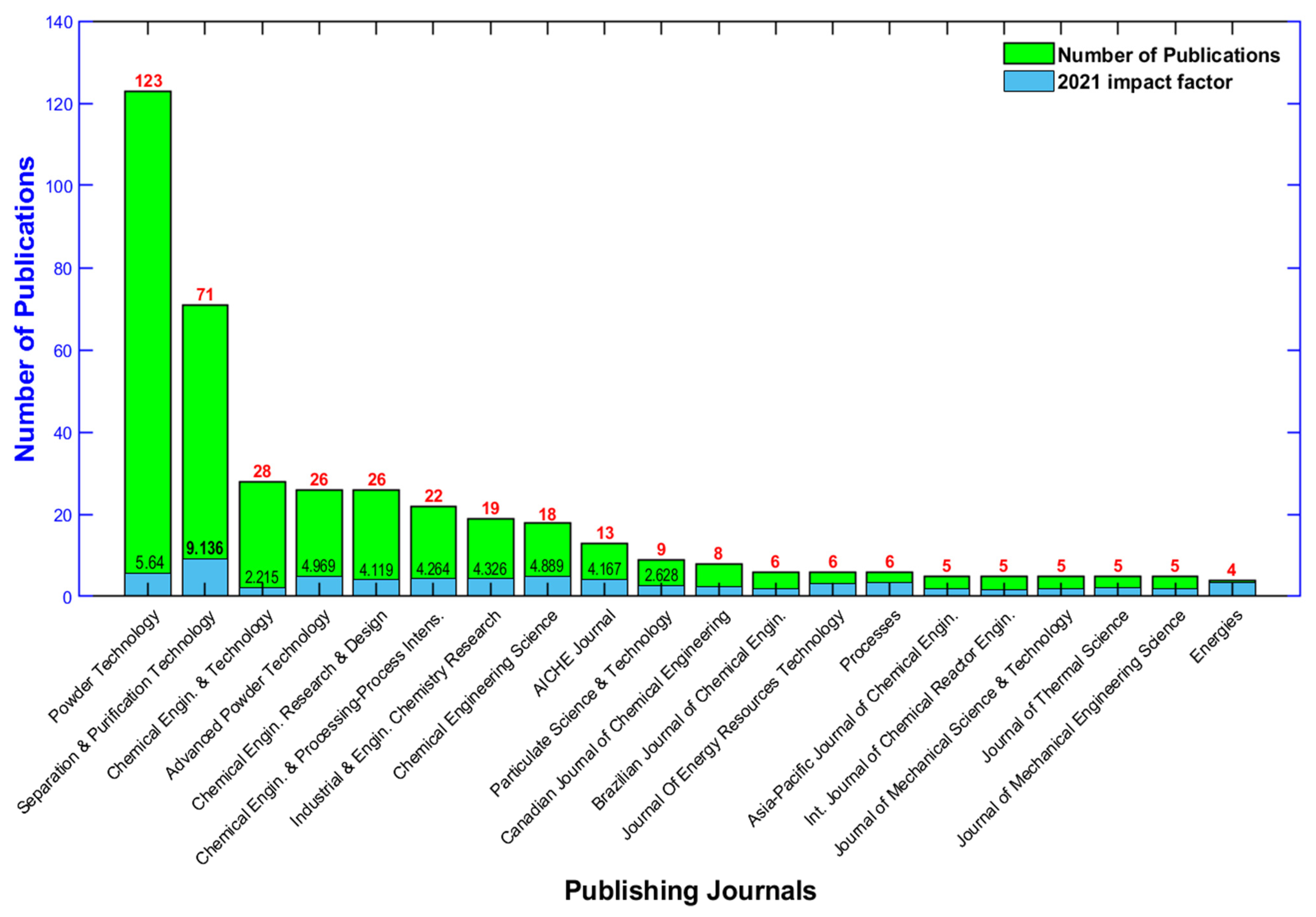
| Screening Criteria | Details |
|---|---|
| TS * | TS = (“cyclone separator”) (n = 693) |
| Period | “2000–2021” (n = 650) |
| Document types | “Articles” and “Review Articles” (n = 554) |
| Database | “Web of Science Core Collection (WoSCC)” (n = 519) |
| Language | “English Language only” (n = 512) |
| Screened articles | cyclone separator related only (n = 487) |
| Publication Variables | Article Records |
|---|---|
| Total number of articles | 487 |
| Publication type: articles | 481 |
| Publication type: review articles | 6 |
| Duration/timespan | 2000–2021 |
| Sources (journals, books) | 70 |
| Mean years from publication | 7.78 |
| Mean citations per publication | 18.91 |
| Mean citations per year per article | 2.12 |
| References | 6252 |
| Keywords plus (ID) | 518 |
| Authors’ keywords (DE) | 930 |
| Authors | 965 |
| Author appearances | 1860 |
| Authors of single-authored publication | 25 |
| Authors of multi-authored publication | 940 |
| Single-authored publication | 33 |
| Publication per author | 0.505 |
| Authors per publication | 1.98 |
| Co-authors per publication | 3.82 |
| Collaboration index | 2.07 |
| Most Productive Countries | Overall Number of Citations per Country | ||||||||||
|---|---|---|---|---|---|---|---|---|---|---|---|
| Rank | Country | Publications | Frequency | % | SCP | MCP | MCPR | Rank | Country | Total Citations | Average Citations |
| 1 | China | 196 | 0.40246 | 40.25 | 168 | 28 | 0.143 | 1 | China | 2975 | 15.18 |
| 2 | Iran | 42 | 0.08624 | 8.62 | 32 | 10 | 0.238 | 2 | Iran | 817 | 19.45 |
| 3 | India | 30 | 0.0616 | 6.16 | 23 | 7 | 0.233 | 3 | India | 583 | 19.43 |
| 4 | Brazil | 20 | 0.04107 | 4.11 | 19 | 1 | 0.05 | 4 | Brazil | 537 | 26.85 |
| 5 | Japan | 19 | 0.03901 | 3.90 | 16 | 3 | 0.158 | 5 | Republic of Korea | 412 | 21.68 |
| 6 | Republic of Korea | 19 | 0.03901 | 3.90 | 17 | 2 | 0.105 | 6 | Belgium | 407 | 67.83 |
| 7 | Poland | 18 | 0.03696 | 3.70 | 14 | 4 | 0.222 | 7 | Australia | 357 | 39.67 |
| 8 | USA | 16 | 0.03285 | 3.29 | 12 | 4 | 0.25 | 8 | Spain | 330 | 66.00 |
| 9 | Canada | 15 | 0.0308 | 3.08 | 9 | 6 | 0.4 | 9 | Japan | 327 | 17.21 |
| 10 | Turkey | 14 | 0.02875 | 2.87 | 14 | 0 | 0 | 10 | United Kingdom | 321 | 29.18 |
| 11 | United Kingdom | 11 | 0.02259 | 2.26 | 11 | 0 | 0 | 11 | Turkey | 288 | 20.57 |
| 12 | Australia | 9 | 0.01848 | 1.85 | 4 | 5 | 0.556 | 12 | Poland | 251 | 13.94 |
| 13 | Belgium | 6 | 0.01232 | 1.23 | 3 | 3 | 0.5 | 13 | Canada | 248 | 16.53 |
| 14 | Norway | 6 | 0.01232 | 1.23 | 2 | 4 | 0.667 | 14 | Norway | 221 | 36.83 |
| 15 | Singapore | 6 | 0.01232 | 1.23 | 4 | 2 | 0.333 | 15 | Malaysia | 134 | 134.00 |
| 16 | Austria | 5 | 0.01027 | 1.03 | 3 | 2 | 0.4 | 16 | USA | 124 | 7.75 |
| 17 | Belarus | 5 | 0.01027 | 1.03 | 1 | 4 | 0.8 | 17 | Sweden | 122 | 30.50 |
| 18 | France | 5 | 0.01027 | 1.03 | 4 | 1 | 0.2 | 18 | Singapore | 119 | 19.83 |
| 19 | Spain | 5 | 0.01027 | 1.03 | 5 | 0 | 0 | 19 | Netherlands | 107 | 53.50 |
| 20 | Sweden | 4 | 0.00821 | 0.82 | 1 | 3 | 0.75 | 20 | France | 106 | 21.20 |
| Rank | Author(s) | NP | h_Index | g_Index | m_Index | TC | PY_Start |
|---|---|---|---|---|---|---|---|
| 1 | Elsayed K. | 14 | 12 | 14 | 0.923 | 654 | 2010 |
| 2 | Sun G. | 14 | 7 | 14 | 0.412 | 203 | 2006 |
| 3 | Wang J. | 16 | 7 | 13 | 0.389 | 191 | 2005 |
| 4 | Yoshida H. | 12 | 8 | 12 | 0.364 | 242 | 2001 |
| 5 | Fukui K. | 11 | 8 | 11 | 0.364 | 213 | 2001 |
| 6 | Zhao B. | 11 | 9 | 11 | 0.474 | 465 | 2004 |
| 7 | Wei Y. | 10 | 5 | 8 | 0.714 | 69 | 2016 |
| 8 | Wang B. | 9 | 6 | 9 | 0.5 | 306 | 2011 |
| 9 | Brar L. | 8 | 7 | 8 | 0.875 | 249 | 2015 |
| 10 | Misiulia D. | 8 | 7 | 8 | 0.875 | 178 | 2015 |
| 11 | Wasilewski M. | 8 | 6 | 8 | 0.857 | 166 | 2016 |
| 12 | Ahmadi G. | 7 | 4 | 7 | 0.667 | 102 | 2017 |
| 13 | Andersson A. | 7 | 7 | 7 | 0.875 | 171 | 2015 |
| 14 | Avci A. | 7 | 6 | 7 | 0.5 | 90 | 2011 |
| 15 | Chen J. | 7 | 5 | 7 | 0.313 | 174 | 2007 |
| 16 | Karagoz I. | 7 | 6 | 7 | 0.4 | 142 | 2008 |
| 17 | Liu Z. | 7 | 5 | 7 | 0.294 | 71 | 2006 |
| 18 | Safikhani H. | 7 | 6 | 7 | 0.5 | 257 | 2011 |
| 19 | Wang D. | 7 | 2 | 4 | 0.5 | 25 | 2019 |
| 20 | Zhang M. | 7 | 5 | 7 | 0.278 | 128 | 2005 |
| First Author | Pub. Year | Journal Name | DOI | Total Citations | TC per Year | Normalized TC |
|---|---|---|---|---|---|---|
| Cortes C. | 2007 | Prog. Energ. Combust. | 10.1016/j.pecs.2007.02.001 | 236 | 14.75 | 6.2457 |
| Slack M.D. | 2000 | Chem. Eng. Res. Des. | 10.1205/026387600528373 | 192 | 8.3478 | 3.0078 |
| Chu K.W. | 2011 | Chem. Eng. Sci. | 10.1016/j.ces.2010.11.026 | 167 | 13.9167 | 4.4415 |
| Elsayed K. | 2010 | Chem. Eng. Sci. | 10.1016/j.ces.2010.08.042 | 150 | 11.5385 | 4.6763 |
| Chuah T.G. | 2006 | Powder Technol. | 10.1016/j.powtec.2005.12.010 | 135 | 7.9412 | 3.7565 |
| Gimbun J. | 2005 | Chem. Eng. Process. | 10.1016/j.cep.2004.03.005 | 134 | 7.4444 | 2.8646 |
| Bernado S. | 2006 | Powder Technol. | 10.1016/j.powtec.2005.11.007 | 134 | 7.8824 | 3.7287 |
| Zhao B. | 2006 | Chem. Eng. Res. Des. | 10.1205/cherd06040 | 131 | 7.7059 | 3.6452 |
| Raoufi A. | 2008 | Chem. Eng. Process. | 10.1016/j.cep.2007.08.004 | 121 | 8.0667 | 4.1987 |
| Hu L.Y. | 2005 | AIChE J. | 10.1002/aic.10354 | 100 | 5.5556 | 2.1378 |
| Derksen J.J. | 2003 | AIChE J. | 10.1002/aic.690490603 | 92 | 4.6 | 2.1801 |
| Elsayed K. | 2012 | Powder Technol. | 10.1016/j.powtec.2011.10.015 | 90 | 8.1818 | 4.2857 |
| Chen J.Y. | 2007 | Powder Technol. | 10.1016/j.powtec.2006.09.014 | 86 | 5.375 | 2.276 |
| Xiang R.B. | 2005 | Chem. Eng. Process. | 10.1016/j.cep.2004.09.006 | 82 | 4.5556 | 1.753 |
| Kaya F. | 2008 | Curr. Sci. India | http:www.jstor.org/stable/24100235 | 79 | 5.2667 | 2.7413 |
| Peng W. | 2002 | Powder Technol. | 10.1016/S0032-5910(02)00148-1 | 78 | 3.7143 | 2.766 |
| Elsayed K. | 2011 | Sol. Energy | 10.1016/j.powtec.2011.05.002 | 77 | 6.4167 | 2.0479 |
| Zhao B.T. | 2004 | Powder Technol. | 10.1016/j.powtec.2004.06.001 | 76 | 4 | 3.4545 |
| Brar L.S. | 2015 | Powder Technol. | 10.1016/j.powtec.2015.09.003 | 74 | 9.25 | 3.0515 |
| Hoffmann A.C. | 2001 | AIChE J. | 10.1002/aic.690471109 | 69 | 3.1364 | 3.4888 |
Publisher’s Note: MDPI stays neutral with regard to jurisdictional claims in published maps and institutional affiliations. |
© 2022 by the authors. Licensee MDPI, Basel, Switzerland. This article is an open access article distributed under the terms and conditions of the Creative Commons Attribution (CC BY) license (https://creativecommons.org/licenses/by/4.0/).
Share and Cite
Alex, F.J.; Tan, G.; Agyeman, P.K.; Ansah, P.O.; Olayode, I.O.; Fayzullayevich, J.V.; Liang, S. Bibliometric Network Analysis of Trends in Cyclone Separator Research: Research Gaps and Future Direction. Sustainability 2022, 14, 14753. https://doi.org/10.3390/su142214753
Alex FJ, Tan G, Agyeman PK, Ansah PO, Olayode IO, Fayzullayevich JV, Liang S. Bibliometric Network Analysis of Trends in Cyclone Separator Research: Research Gaps and Future Direction. Sustainability. 2022; 14(22):14753. https://doi.org/10.3390/su142214753
Chicago/Turabian StyleAlex, Frimpong J., Gangfeng Tan, Philip K. Agyeman, Prince O. Ansah, Isaac O. Olayode, Jamshid V. Fayzullayevich, and Shuang Liang. 2022. "Bibliometric Network Analysis of Trends in Cyclone Separator Research: Research Gaps and Future Direction" Sustainability 14, no. 22: 14753. https://doi.org/10.3390/su142214753
APA StyleAlex, F. J., Tan, G., Agyeman, P. K., Ansah, P. O., Olayode, I. O., Fayzullayevich, J. V., & Liang, S. (2022). Bibliometric Network Analysis of Trends in Cyclone Separator Research: Research Gaps and Future Direction. Sustainability, 14(22), 14753. https://doi.org/10.3390/su142214753








